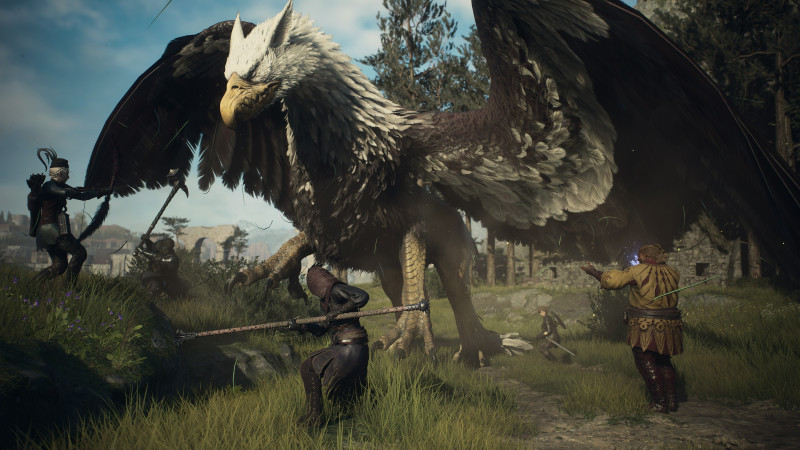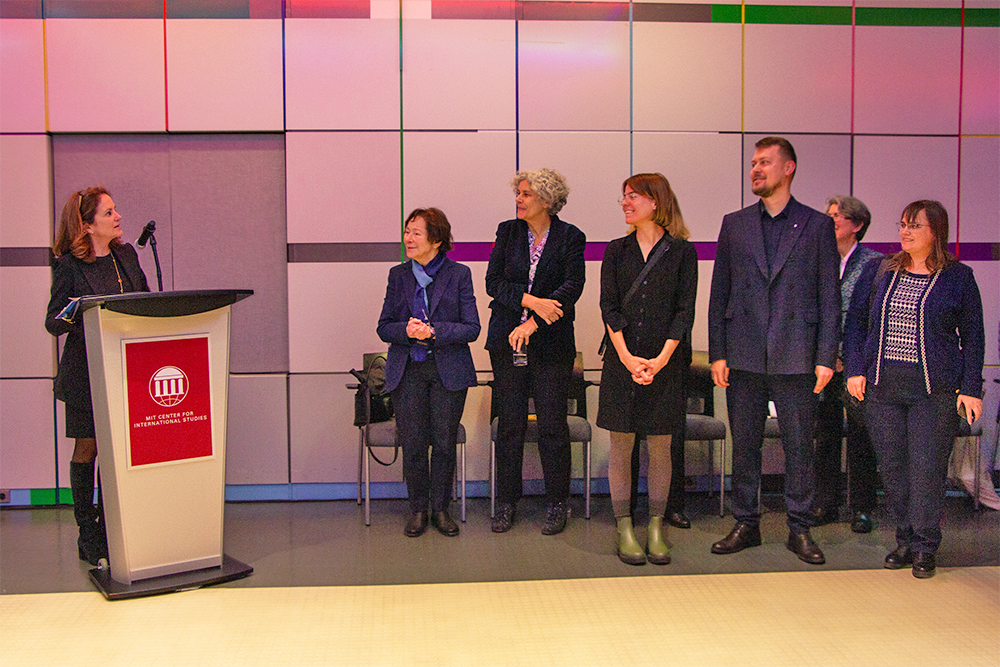Even before Russia’s invasion of Ukraine two years ago, members of the MIT faculty knew that violence and political pressures in the region endangered the work and well-being of Ukrainian scholars and contemplated how MIT could assist. The start of the full-scale invasion in February 2022 was the decisive catalyst — triggering the launch of the MIT-Ukraine Program later that year and eventually spurring creation of the new Global MIT At-Risk Fellows (GMAF) program with an initial focus on Ukraine.
Designed to provide sanctuary to scholars around the globe whose lives and academic freedom have been upended by war and tragedy in their countries, GMAF aspires to bring up to five international scholars annually to the MIT campus for semester-long study and research that will ultimately benefit their countries and simultaneously enrich the MIT community. Welcoming the program’s first three visiting scholars from Ukraine, GMAF officially kicked off on Feb. 29 at a reception hosted by the Office of the Vice Provost for International Activities and the MIT Center for International Studies.
The reception showcased the varied struggles of displaced individuals with the photographic exhibition, “Standing for freedom, portraits of scientists in exile,” comprising portraits of refugee scholars from countries torn by war and political upheaval. This inaugural U.S. installation will be on public display at MIT’s Koch Institute Public Galleries (Building 76) from April 3 through April 30. It then travels to the French Embassy in Washington. It is the work of PAUSE, a French organization that has enabled scientists in exile to continue their work in France since 2017.
“It’s the first time the exhibit has been in the United States, and we are very proud and honored that it is here,” says PAUSE Executive Director Laura Loheac, who participated in the Feb. 29 event along with PAUSE co-founder Professor Pascale Laborier, photographer Pierre-Jérôme Adjedj, members of the local Ukrainian community, and MIT faculty, students, and senior staff.
Ford International Professor of History Elizabeth Wood said Russia’s full-scale invasion of Ukraine “is not only tragic in its own right,” but “has also created a host of dire scientific and technological problems that we think MIT faculty, staff, and students are well positioned to help solve in collaboration with Ukrainians themselves.”
“Our focus in the MIT-Ukraine Program — itself launched just 16 months ago — has been to serve as a Ukraine hub at MIT,” said Wood, faculty chair for both GMAF and MIT-Ukraine. “The core idea of the GMAF Program in its current incarnation is to bring Ukrainian scholars to MIT for a semester so they can have a bit of a refuge from the war — though I know it is never far from their minds, and so they can soak up some of MIT’s famous culture of ‘mens et manus’ — mind, hands, and heart.”
GMAF scholars Liudmyla Huliaieva and Kateryna Lopatiuk have been at MIT for about a month, while the cohort’s third member, Dmytro Chumachenko, arrived one day before the reception due to visa processing delays. Huliaieva is an economist focused on the economic adaptation and survival of Ukrainian displaced women, while Lopatiuk is an architect and urban planner involved in rebuilding cities and towns across Ukraine, and Chumachenko is a multidisciplinary scientist working at the intersection of artificial intelligence and public health. All met rigorous criteria considered by faculty committee members who evaluated 80 applications for GMAF’s first group of scholars.
“We wanted individuals who were deeply committed to helping Ukraine, who could benefit from a place at MIT, who were providing absolutely top-notch scholarship, who could actually leave the country — since many men and some women cannot do that because of circumstances of the war — and who had projects they were ready and eager to pursue while here,” Wood says.
Huliaieva, Lopatiuk, and Chumachenko are the first of what will likely be 10 Ukrainian researchers and faculty spending a semester at MIT during the two-year GMAF pilot program. With additional funding, the program is envisioned to eventually expand to help scholars in other countries where their work is jeopardized by war or displacement. Provost Cynthia Barnhart says the three Ukrainian scholars now on campus “represent just the start.”
Event speakers noted GMAF’s collaborative nature. Among those recognized for conceiving and organizing it were MIT Vice Provost for International Activities Richard Lester, Senior Director Beth Dupuy, and Institute Professor Suzanne Berger — event emcee and founding director of the MIT International Science and Technology Initiatives (MISTI). Credited for implementing the new program was Svitlana Krasynska, program director for both MIT-Ukraine and GMAF.
Lester said about the program, “The threats to science and scholarship from war and political repression are profound and, unfortunately, they are growing around the world. Even though the GMAF program is small relative to the vast need, it is a practical way for MIT to contribute and also to demonstrate our solidarity with vulnerable members of the global academic community of which we are part.”
Krasynska said in an interview that, although the exact number is currently unknown, it is estimated that over 60,000 Ukrainian scholars and support staff have been displaced and many universities destroyed or badly damaged in the past two years.
“Lives have been severely disrupted,” said Krasynska, who was born and raised in Ukraine and has lived in the United States since 1997. “We really need to support Ukrainian scientists and support Ukrainian science because it is in dire straits right now.”
Chumachenko said his home campus, the National Aerospace University Kharkiv Aviation Institute, has suffered 160 Russian bombs, “but we are still working and teaching.”
“Besides what we bring back to Ukraine, I believe the three of us can bring something here,” he said. “People know about the Russian war in Ukraine through TV, but it’s not always the full picture.”
Lopatiuk echoed those sentiments. Noting that when she applied to the GMAF program she had several research goals in mind, but realized after spending the past month at MIT that “my main purpose is also to get students to get to know what Ukraine is as a country beyond the consequences of war” — including the nation’s history, culture and ideas.
Noting that her first impression of MIT “is that it’s a very big, friendly family,” Huliaieva plans to present a virtual seminar at Harvard University on March 18 designed to broaden awareness and understanding of the challenges faced by Ukrainians — both those still there and people forced to leave. Titled “Dreaming of home: Displaced Ukrainian women between transience and permanency,” it reflects her research into helping Ukrainian women gain financial independence and freedom.
Barnhart welcomed Huliaieva, Lopatiuk, and Chumachenko to MIT “not only as our very first cohort of scholars, but also as colleagues and collaborators.”
“I hope you’ll find our entire campus is a thriving ecosystem of ideas and innovation,” she said. “I hope you will learn that we are deeply committed to protecting education and scholarship whenever they come under threat.”



